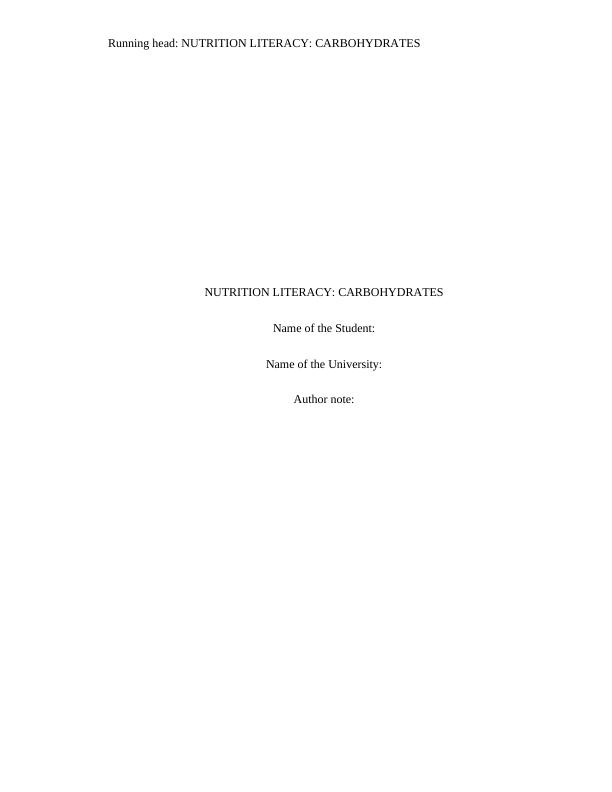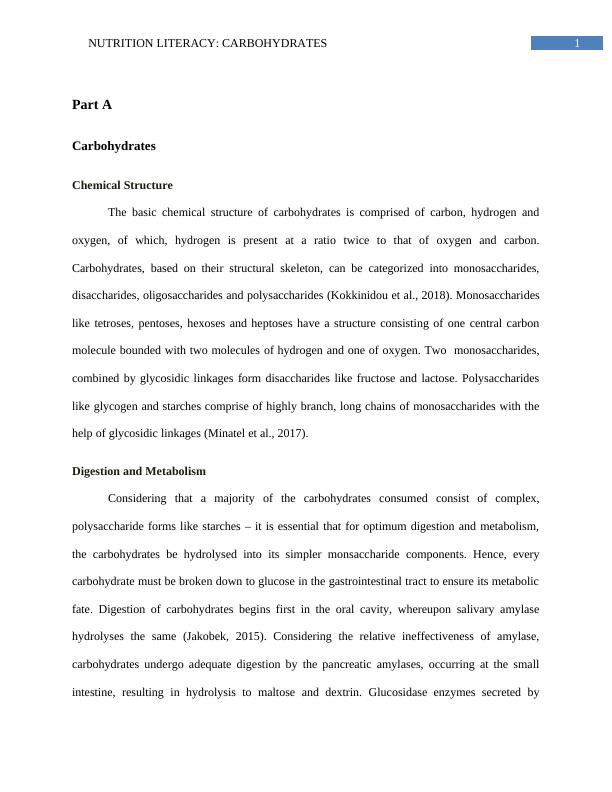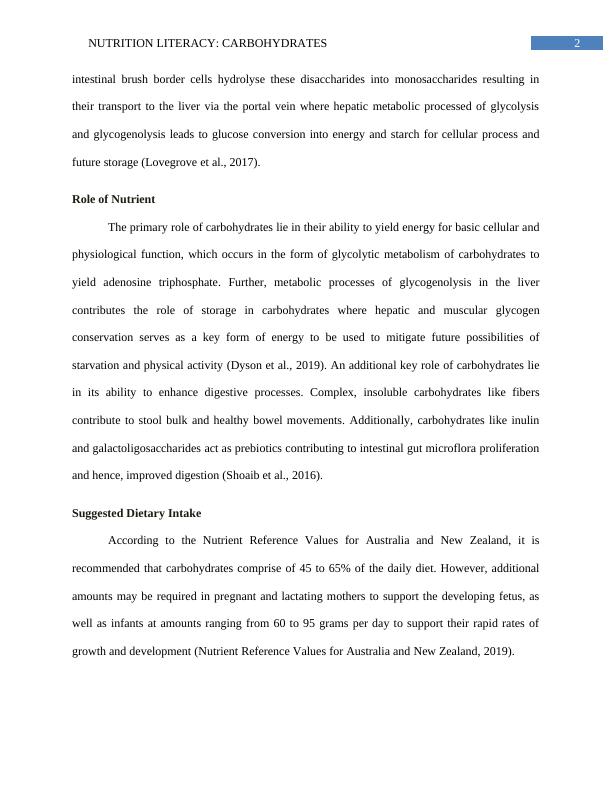Nutrition Literacy: Carbohydrates
Added on 2022-11-17
10 Pages2524 Words331 Views
Running head: NUTRITION LITERACY: CARBOHYDRATES
NUTRITION LITERACY: CARBOHYDRATES
Name of the Student:
Name of the University:
Author note:
NUTRITION LITERACY: CARBOHYDRATES
Name of the Student:
Name of the University:
Author note:

1NUTRITION LITERACY: CARBOHYDRATES
Part A
Carbohydrates
Chemical Structure
The basic chemical structure of carbohydrates is comprised of carbon, hydrogen and
oxygen, of which, hydrogen is present at a ratio twice to that of oxygen and carbon.
Carbohydrates, based on their structural skeleton, can be categorized into monosaccharides,
disaccharides, oligosaccharides and polysaccharides (Kokkinidou et al., 2018). Monosaccharides
like tetroses, pentoses, hexoses and heptoses have a structure consisting of one central carbon
molecule bounded with two molecules of hydrogen and one of oxygen. Two monosaccharides,
combined by glycosidic linkages form disaccharides like fructose and lactose. Polysaccharides
like glycogen and starches comprise of highly branch, long chains of monosaccharides with the
help of glycosidic linkages (Minatel et al., 2017).
Digestion and Metabolism
Considering that a majority of the carbohydrates consumed consist of complex,
polysaccharide forms like starches – it is essential that for optimum digestion and metabolism,
the carbohydrates be hydrolysed into its simpler monsaccharide components. Hence, every
carbohydrate must be broken down to glucose in the gastrointestinal tract to ensure its metabolic
fate. Digestion of carbohydrates begins first in the oral cavity, whereupon salivary amylase
hydrolyses the same (Jakobek, 2015). Considering the relative ineffectiveness of amylase,
carbohydrates undergo adequate digestion by the pancreatic amylases, occurring at the small
intestine, resulting in hydrolysis to maltose and dextrin. Glucosidase enzymes secreted by
Part A
Carbohydrates
Chemical Structure
The basic chemical structure of carbohydrates is comprised of carbon, hydrogen and
oxygen, of which, hydrogen is present at a ratio twice to that of oxygen and carbon.
Carbohydrates, based on their structural skeleton, can be categorized into monosaccharides,
disaccharides, oligosaccharides and polysaccharides (Kokkinidou et al., 2018). Monosaccharides
like tetroses, pentoses, hexoses and heptoses have a structure consisting of one central carbon
molecule bounded with two molecules of hydrogen and one of oxygen. Two monosaccharides,
combined by glycosidic linkages form disaccharides like fructose and lactose. Polysaccharides
like glycogen and starches comprise of highly branch, long chains of monosaccharides with the
help of glycosidic linkages (Minatel et al., 2017).
Digestion and Metabolism
Considering that a majority of the carbohydrates consumed consist of complex,
polysaccharide forms like starches – it is essential that for optimum digestion and metabolism,
the carbohydrates be hydrolysed into its simpler monsaccharide components. Hence, every
carbohydrate must be broken down to glucose in the gastrointestinal tract to ensure its metabolic
fate. Digestion of carbohydrates begins first in the oral cavity, whereupon salivary amylase
hydrolyses the same (Jakobek, 2015). Considering the relative ineffectiveness of amylase,
carbohydrates undergo adequate digestion by the pancreatic amylases, occurring at the small
intestine, resulting in hydrolysis to maltose and dextrin. Glucosidase enzymes secreted by

2NUTRITION LITERACY: CARBOHYDRATES
intestinal brush border cells hydrolyse these disaccharides into monosaccharides resulting in
their transport to the liver via the portal vein where hepatic metabolic processed of glycolysis
and glycogenolysis leads to glucose conversion into energy and starch for cellular process and
future storage (Lovegrove et al., 2017).
Role of Nutrient
The primary role of carbohydrates lie in their ability to yield energy for basic cellular and
physiological function, which occurs in the form of glycolytic metabolism of carbohydrates to
yield adenosine triphosphate. Further, metabolic processes of glycogenolysis in the liver
contributes the role of storage in carbohydrates where hepatic and muscular glycogen
conservation serves as a key form of energy to be used to mitigate future possibilities of
starvation and physical activity (Dyson et al., 2019). An additional key role of carbohydrates lie
in its ability to enhance digestive processes. Complex, insoluble carbohydrates like fibers
contribute to stool bulk and healthy bowel movements. Additionally, carbohydrates like inulin
and galactoligosaccharides act as prebiotics contributing to intestinal gut microflora proliferation
and hence, improved digestion (Shoaib et al., 2016).
Suggested Dietary Intake
According to the Nutrient Reference Values for Australia and New Zealand, it is
recommended that carbohydrates comprise of 45 to 65% of the daily diet. However, additional
amounts may be required in pregnant and lactating mothers to support the developing fetus, as
well as infants at amounts ranging from 60 to 95 grams per day to support their rapid rates of
growth and development (Nutrient Reference Values for Australia and New Zealand, 2019).
intestinal brush border cells hydrolyse these disaccharides into monosaccharides resulting in
their transport to the liver via the portal vein where hepatic metabolic processed of glycolysis
and glycogenolysis leads to glucose conversion into energy and starch for cellular process and
future storage (Lovegrove et al., 2017).
Role of Nutrient
The primary role of carbohydrates lie in their ability to yield energy for basic cellular and
physiological function, which occurs in the form of glycolytic metabolism of carbohydrates to
yield adenosine triphosphate. Further, metabolic processes of glycogenolysis in the liver
contributes the role of storage in carbohydrates where hepatic and muscular glycogen
conservation serves as a key form of energy to be used to mitigate future possibilities of
starvation and physical activity (Dyson et al., 2019). An additional key role of carbohydrates lie
in its ability to enhance digestive processes. Complex, insoluble carbohydrates like fibers
contribute to stool bulk and healthy bowel movements. Additionally, carbohydrates like inulin
and galactoligosaccharides act as prebiotics contributing to intestinal gut microflora proliferation
and hence, improved digestion (Shoaib et al., 2016).
Suggested Dietary Intake
According to the Nutrient Reference Values for Australia and New Zealand, it is
recommended that carbohydrates comprise of 45 to 65% of the daily diet. However, additional
amounts may be required in pregnant and lactating mothers to support the developing fetus, as
well as infants at amounts ranging from 60 to 95 grams per day to support their rapid rates of
growth and development (Nutrient Reference Values for Australia and New Zealand, 2019).

End of preview
Want to access all the pages? Upload your documents or become a member.
Related Documents
Biology Nutrition and Digestionlg...
|5
|829
|121
Importance of Nutrient Carbohydrate - PDFlg...
|12
|2723
|499
The Role of Macronutrient Carbohydrateslg...
|7
|1587
|317
CM 2 Carbohydrate Metabolismlg...
|12
|3301
|11
Biology Questions Assignmentlg...
|4
|490
|16
Biomolecules | Carbohydrates, Lipids, and Proteinslg...
|7
|1639
|29